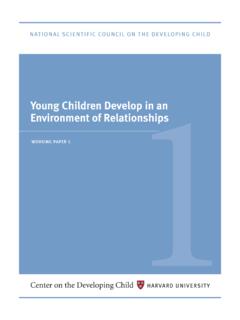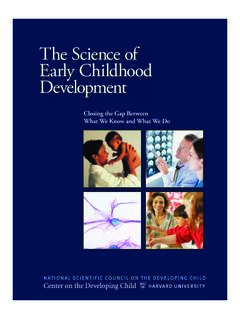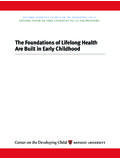Transcription of Children's Emotional Development Is Built into the ...
1 children s Emotional Development Is Built into the Architecture of Their BrainsWORKING PAPER 22 MEMBERS Jack P. Shonkoff, , Chair Julius B. Richmond FAMRI Professor of Child Health and Development , Harvard School of Public Health and Harvard Graduate School of Education; Professor of Pediatrics, Harvard Medical School and children s Hospital Boston; Director, Center on the Developing Child, Harvard UniversityPat Levitt, , Science Director Director, Zilkha Neurogenetic Institute; Provost Professor of Neuroscience, Psychiatry & Pharmacy; Chair, Department of Cell and Neurobiology, Keck School of Medicine, University of Southern CaliforniaW. Thomas Boyce, Sunny Hill Health Centre/BC Leadership Chair in Child Development ; Professor, College for Interdisciplinary Studies and Faculty of Medicine, University of British ColumbiaNathan A. Fox, Distinguished University Professor; Director, Child Development Laboratory, University of Maryland College ParkMegan Gunnar, Regents Professor and Distinguished McKnight University Professor, Institute of Child Development , University of MinnesotaLinda C.
2 Mayes, Arnold Gesell Professor of Child Psychiatry, Pediatrics, and Psychology, Yale Child Study Center; Special Advisor to the Dean, Yale School of MedicineBruce S. McEwen, Alfred E. Mirsky Professor; Head, Harold and Margaret Milliken Hatch Laboratory of Neuroendocrinology, The Rockefeller UniversityCharles A. Nelson III, Richard David Scott Chair in Pediatric Developmental Medicine Research, children s Hospital Boston; Professor of Pediatrics and Neuroscience, Harvard Medical SchoolRoss Thompson, Professor of Psychology, University of California, Davis CONTRIBUTING MEMBERS Susan Nall Bales President, FrameWorks InstituteJudy Cameron, Professor of Psychiatry, University of PittsburghGreg Duncan, Distinguished Professor, Department of Education, University of California, IrvinePhilip A. Fisher, Professor of Psychology and Director, Stress Neurobiology and Prevention Research Laboratory, University of Oregon; Senior Scientist, Oregon Social Learning CenterWilliam Greenough, Swanlund Professor of Psychology, Psychiatry, and Cell and Developmental Biology; Director, Center for Advanced Study at University of Illinois, Urbana-ChampaignEric Knudsen, Edward C.
3 And Amy H. Sewall Professor of Neurobiology, Stanford University School of MedicineDeborah Phillips, Professor of Psychology and Associated Faculty, Public Policy Institute; Co-Director, Research Center on children in the , Georgetown UniversityArthur J. Rolnick, Senior Fellow and Co-Director, Human Capital Research Collaborative, Humphrey School of Public Affairs, University of MinnesotaFORMER MEMBERS James Heckman, Henry Schultz Distinguished Service Professor of Economics; Director, Economics Research Center, Department of Economics; Director, Center for Social Program Evaluation, University of ChicagoBetsy Lozoff, Professor of Pediatrics, University of Michigan Medical School; Research Professor, Center for Human Growth and Development , University of Michigan About the AuthorsThe National Scientific Council on the Developing Child, housed at the Center on the Developing Child at Harvard University, is a multidisciplinary collaboration designed to bring the science of early childhood and early brain Development to bear on public decision-making.
4 Established in 2003, the Council is committed to an evidence-based approach to building broad-based public will that transcends political partisanship and recognizes the complementary responsibilities of family, community, workplace, and government to promote the well-being of all young children . For more information, go to Please note: The content of this paper is the sole responsibility of the authors and does not necessarily represent the opinions of the funders or citation: National Scientific Council on the Developing Child (2004). children s Emotional Development Is Built into the Architecture of Their Brains: Working Paper No. 2. 2004, National Scientific Council on the Developing Child, Center on the Developing Child at Harvard UniversityPARTNERS FrameWorks InstituteJohnson & Johnson Pediatric Institute National Governors Association Center for Best Practices National Conference of State LegislaturesSPONSORS Birth to Five Policy Alliance Buffett Early Childhood FundSusan A.
5 Buffett FoundationCasey Family Programs The John D. and Catherine T. MacArthur FoundationPalix FoundationTHIRD PRINTING: AUGUST children s Emotional Development Is Built into the Architecture of Their Brains 1 From birth, children rapidly develop their abilities to experience and express different emotions, as well as their capacity to cope with and manage a variety of ,2,3 The devel-opment of these capabilities occurs at the same time as a wide range of highly visible skills in mobility (motor control), thinking (cognition), and communication (language).4 Yet, Emotional Development often receives relatively less recognition as a core emerging capacity in the early childhood years. The foun-dations of social competence that are developed in the first five years are linked to Emotional well-being and affect a child s later ability to functionally adapt in school and to form suc-cessful relationships throughout ,6,7,8 As a person develops into adulthood, these same social skills are essential for the formation of lasting friendships and intimate relation-ships, effective parenting, the ability to hold a job and work well with others, and for becom-ing a contributing member of a ,10 Disregarding this critical aspect of the developing child can lead parents and policymak-ers to underestimate its importance and to ignore the foundation that emotions establish for later growth and Development .
6 Thus, it is essential that young children s feelings get the same level of at-tention as their thinking. Indeed, learning to man-age emotions is more difficult for some children than learning to count or read and may, in some cases, be an early warning sign of future psycho-logical problems. The failure to address difficul-ties in this equally important domain can result in missed opportunities for interventions. Had they been initiated early, these interventions could have yielded tremendous benefits for large numbers of children and for core features of Emotional develop-ment include the ability to identify and un-derstand one s own feelings, to accurately read and comprehend Emotional states in others, to manage strong emotions and their expression in a constructive manner, to regulate one s own behavior, to develop empathy for others, and to establish and sustain ,11,12 Emotional Development is actually Built into the architecture of young children s brains in response to their individual personal experi-ences and the influences of the environments in which they live.
7 Indeed, emotion is a biologically based aspect of human functioning that is wired into multiple regions of the central nervous system that have a long history in the evolution of our ,14,15,16,17 These growing interconnections among brain circuits support the emergence of increas-ingly mature Emotional behavior, particularly in the preschool years. Stated simply, as young children develop, their early Emotional experi-ences literally become embedded in the archi-tecture of their brains. Here is what we know: The Emotional experiences of newborns and young infants occur most commonly during pe-riods of interaction with a caregiver (such as feeding, comforting, and holding).8,11,18,19 Infants display distress and cry when they are hungry, The Issuea growing body of scientific evidence tells us that Emotional Development begins early in life, that it is a critical aspect of the Development of overall brain architecture, and that it has enormous consequences over the course of a lifetime.
8 These findings have far-reaching implica-tions for policymakers and parents, and, therefore, demand our Science Tells UsAs young children develop, their early Emotional experiences literally become embedded in the architecture of their children s Emotional Development Is Built into the Architecture of Their Brains SCIENTIFIC COUNCIL ON THE DEVELOPING CHILDThe Emotional health of young children is closely tied to the social and Emotional characteristics of the environments in which they , wet, or in other ways uncomfortable, and they experience positive emotions when they are fed, soothed, and held. During this early pe-riod, children are incapable of modulating the expression of overwhelming feelings, and they have limited ability to control their emotions in the service of focusing or sustaining Associations between positive emotions and the availability of sensitive and respon-sive caregiving are strengthened during infan-cy in both behavior and brain The Emotional states of toddlers and preschool-ers are much more They depend on their emerging capacities to interpret their own personal experiences and understand what others are doing and thinking, as well as to interpret the nuances of how others re-spond to ,11,22,23 As they (and their brains) build on foundations that are estab-lished earlier, they mature and acquire a bet-ter understanding of a range of emotions.
9 They also become more capable of manag-ing their feelings, which is one of the most challenging tasks of early ,24,25,26,27 By the end of the preschool years, children who have acquired a strong Emotional foundation have the capacity to anticipate, talk about, and use their awareness of their own and others feelings to better manage everyday social ,11 Their Emotional repertoires have expanded dramatically and now include such feelings as pride, shame, guilt, and embarrass-ment all of which influence how individu-als function as contributing members of a ,28 Throughout the early childhood years, children develop increasing capacities to use language to communicate how they feel and to gain help without melting down, as well as to inhibit the expression of emotions that are inappropriate for a particular ,29 When feelings are not well managed, thinking can be impaired.
10 Recent scientific advances have shown how the interrelated Development of emotion and cognition relies on the emergence, maturation, and interconnection of complex neural circuits in multiple areas of the brain, including the prefrontal cortex, limbic cortex, basal forebrain, amygdala, hypothalamus, and The circuits that are involved in the regulation of emotion are highly interactive with those that are associated with executive functions (such as planning, judgment, and decision-making), which are intimately in-volved in the Development of problem-solving skills during the preschool In terms of basic brain functioning, emotions support executive functions when they are well regu-lated but interfere with attention and decision- making when they are poorly ,32,33,34,35 We now know that differences in early childhood temperament ranging from being extremely outgoing and adventurous to being painfully shy and easily upset by anything new or unusual are grounded in one s biological ,37 These variations lead to alternative behavioral pathways for young children as they develop in-dividual strategies to control their emotions dur-ing the preschool years and beyond.








